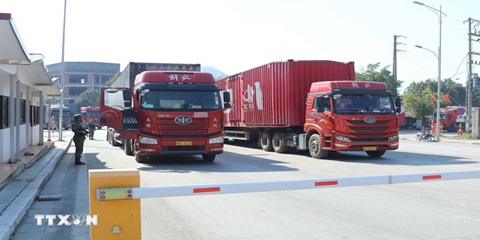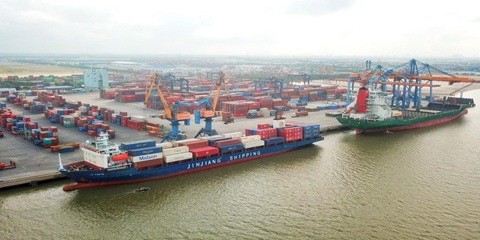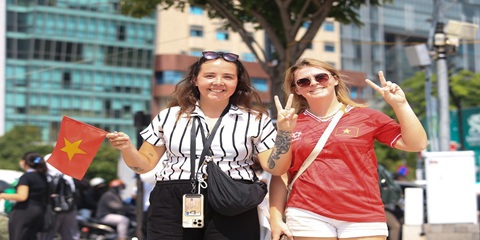Want to be in the loop?
subscribe to
our notification
Business News
GARMENT SECTOR EXPORT GROWTH STILL UNSUSTAINABLE
Việt Nam’s garment and textile revenue increased for the first half of this year but experts said the growth has not yet become sustainable.
The national garment and textiles export value in the first half of the year grew 11.3 per cent year-on-year to US$14.58 billion, higher than the growth rate of 6.1 per cent year-on-year in the same period of 2016.
Lê Tiến Trường, deputy general director of the Việt Nam Garment and Textile Group (Vinatex), said the results by the garment sector were a praiseworthy effort in the context of the unstable global economy.
The demand for textile products from key importers like the United States (US), the European Union (EU) and Japan tapered off in the first six months of the year. However, exports to those markets experienced robust achievements, Trường said.
He said that the country earned $6 billion from the exports to the US, surging nearly 9 per cent; $2.3 billion to the EU, up 8 per cent; and $1.5 billion to Japan, up 12 per cent.
Việt Nam outstripped its competitors in garment exports during the period. According to the Trade Map, China experienced a decline of more than 5 per cent year-on-year, while Bangladesh saw a drop of 3.5 per cent, and Indonesia was down 5 per cent.
However, the trade protectionism policy of US President Donald Trump’s administration and interest rate adjustment from the US Federal Reserve will threaten sustainable export growth. There is a high possibility that Việt Nam’s competitors will further devalue domestic currencies to support exports as they did in 2016, Trường said.
As the biggest hurdle for Vietnamese garments is foreign competitors, especially China with large scale production and low costs, Vietnamese enterprises need to join the global supply chain with fastidious requirements of quality, prices and time of good delivery.
Local enterprises’ poor orientations have made them fail to meet the industry’s long-term development. In addition, unsound competition between domestic and foreign invested businesses has been on the cards.
Moreover, the auxiliary industry for the textile and garment sector has not yet developed. Low capacity in the stages of weaving and dyeing have led to the local demand for textile fabric being unsatisfied. The domestic garment industry must import 70 per cent of fabric, causing unbalanced development.
Meanwhile, Vietnamese garment enterprises are mostly small- and medium-sized ones with limited ability in accessing domestic and foreign markets. If they do not link with some large enterprises, these firms will find it difficult to survive and never have the ability to compete internationally.
Local garment enterprises have also faced many challenges, including the shortage of high-quality human resources, limitations in product development, capital access, marketing and foreign languages, and high input costs.
The garment sector recommended to the relevant authorities that they support training programmes in original design manufacturer (ODM) business and information and technology while creating favourable conditions for enterprises to have access to soft loans and preventing smuggled goods.
Source: VIR
Related News

VIETNAM’S SEAFOOD EXPORTS HIT OVER US$10 BILLION IN JAN-NOV
Seafood export revenue in November alone amounted to nearly US$990 million, up 6.6% year-on-year. Key product groups posted solid gains. Shrimp exports rose 11.7% to over US$385 million, supported by strong demand for whiteleg shrimp and lobster. Tra fish shipments increased 9.7% to almost US$197 million, while marine fish, squid, and mollusk exports maintained their recovery.

VIETNAM’S AGRO-FORESTRY-FISHERY EXPORTS HIT NEW RECORD IN JAN-NOV
Vietnam’s agro-forestry-fishery export revenue reached an estimated US$64.01 billion in the first 11 months of 2025, up 12.6% year-on-year and surpassing the full-year record of US$62.4 billion set in 2024. Agricultural exports reached US$34.24 billion, up 15% year-on-year, while livestock products brought in US$567.4 million, a 16.8% increase. Seafood exports rose 13.2% to US$10.38 billion, and forestry products earned US$16.61 billion, up 5.9%.

HANOI REPORTS RECORD-HIGH BUDGET REVENUE IN 2025
Hanoi’s budget revenue is estimated to reach VND641.7 trillion in 2025, the highest level ever recorded and nearly 25% above the revised target, according to a report by the municipal government. Data from the city’s socioeconomic performance review shows that total state budget collections in 2025 are projected to reach 124.9% of the adjusted plan and rise 24.9% from 2024, the Vietnam News Agency reported.

VIETNAM, CHINA TO PILOT TWO-WAY CARGO TRANSPORT AT LANG SON BORDER
Vietnam and China will launch a one-year pilot program on December 10 to allow two-way cargo transport through the Huu Nghi–Youyi Guan international border gates in Lang Son Province, reported the Vietnam News Agency. The Dong Dang-Lang Son Economic Zone Management Board said the trial aims to reduce transport costs and improve customs clearance capacity.

VIETNAM’S IMPORT-EXPORT VALUE NEARS US$840 BILLION IN JAN-NOV
The total value of Vietnam’s imports and exports was nearly US$840 billion between January and November this year, the highest level ever recorded, according to the National Statistics Office. In its latest report on the country’s socio-economic performance, the National Statistics Office highlighted a series of positive economic indicators, with trade emerging as one of the strongest drivers of growth.

OVER 19 MILLION INTERNATIONAL VISITORS COME TO VIETNAM IN JAN-NOV
Vietnam received more than 19.1 million international visitors in the first 11 months of 2025, a 20.9% increase year-on-year and the highest level ever recorded, according to the National Statistics Office. The figure surpasses the full-year record of 18 million arrivals set in 2019, before the Covid-19 pandemic. Nearly two million foreign visitors arrived in November alone, up 14.2% from October and 15.6% from the same period last year.
























